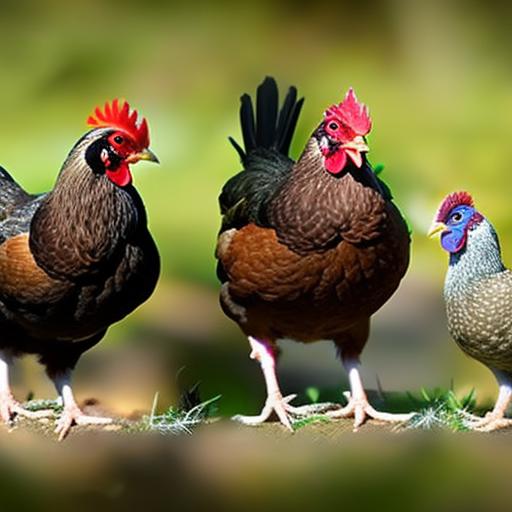Keeping chickens is a popular hobby for many people, whether they live in rural areas or urban settings. Chickens not only provide fresh eggs but also serve as pets and sources of entertainment. However, it is important to understand the social hierarchy and compatibility among different chicken breeds in order to maintain a peaceful and harmonious flock. This article will explore the importance of understanding social hierarchy and compatibility among chicken breeds, as well as provide tips for keeping different breeds together.
Key Takeaways
- Chickens have a social hierarchy, with dominant and submissive individuals.
- Compatibility among different breeds is important to maintain a peaceful flock.
- Factors to consider before keeping different breeds together include size, temperament, and egg-laying habits.
- Keeping multiple breeds of chickens can provide benefits such as increased egg diversity and disease resistance.
- Common breeds that can be kept together include Rhode Island Reds, Plymouth Rocks, and Wyandottes.
Understanding the Social Hierarchy of Chickens
Chickens have a social hierarchy known as the pecking order. This hierarchy determines the social status of each chicken within the flock. The pecking order is established through aggressive behaviors such as pecking, chasing, and wing flapping. The dominant chickens are at the top of the hierarchy and have priority access to food, water, and other resources.
Understanding the pecking order is crucial for maintaining a peaceful flock. Chickens that are lower in the pecking order may experience stress and aggression from dominant chickens. This can lead to injuries, feather picking, and even death if not properly managed. By understanding the social hierarchy, chicken owners can take steps to prevent or minimize aggression within their flock.
The Importance of Compatibility Among Different Breeds
Keeping compatible breeds together is important for several reasons. First, compatible breeds are more likely to get along and establish a harmonious flock. This reduces stress and aggression among chickens, leading to a healthier and happier flock overall.
Second, having a diverse flock can provide several benefits. Different breeds have different characteristics and traits, such as egg production, egg color, size, and temperament. By keeping multiple breeds together, chicken owners can enjoy a variety of eggs and personalities within their flock.
Factors to Consider Before Keeping Different Breeds Together
Before keeping different breeds together, there are several factors that need to be considered. First, the size and temperament of different breeds should be taken into account. Some breeds are more aggressive or dominant than others, and may not get along well with certain breeds. It is important to research the characteristics of each breed and choose compatible breeds to keep together.
Second, space requirements should be considered. Different breeds have different space requirements, and overcrowding can lead to stress and aggression among chickens. It is important to provide enough space for each breed to roam and establish their own territory.
Lastly, feeding habits should be taken into consideration. Some breeds may have different dietary needs or feeding habits, and it is important to ensure that all chickens have access to food and water without competition or aggression.
The Benefits of Keeping Multiple Breeds of Chickens
Keeping multiple breeds of chickens can provide several benefits. First, it can increase egg production. Different breeds have different egg-laying capabilities, and by keeping multiple breeds together, chicken owners can enjoy a higher overall egg production.
Second, keeping multiple breeds can provide more variety in egg colors and sizes. Some breeds lay brown eggs, while others lay white or even blue or green eggs. By keeping different breeds together, chicken owners can have a colorful assortment of eggs.
Lastly, having a diverse flock can provide better pest control. Different breeds may have different foraging behaviors and preferences, which can help control pests such as insects and weeds in the chicken coop or yard.
Common Breeds That Can Be Kept Together

There are several common chicken breeds that can be kept together due to their compatibility. Some examples include:
1. Rhode Island Red: Rhode Island Reds are known for their friendly and docile nature. They get along well with other breeds and are good layers of brown eggs.
2. Sussex: Sussex chickens are known for their calm and friendly temperament. They are good layers of brown eggs and get along well with other breeds.
3. Australorp: Australorps are known for their gentle and friendly nature. They are good layers of brown eggs and get along well with other breeds.
4. Orpington: Orpington chickens are known for their calm and friendly temperament. They are good layers of brown eggs and get along well with other breeds.
Breeds That Should Be Kept Separate From Each Other
While there are many compatible breeds, there are also some breeds that should be kept separate from each other due to their incompatible nature. Some examples include:
1. Leghorn: Leghorns are known for their high energy and flighty nature. They can be aggressive towards other breeds and may not get along well in a mixed flock.
2. Gamefowl: Gamefowl breeds, such as the American Game or Old English Game, are known for their aggressive and dominant nature. They should be kept separate from other breeds to prevent aggression.
3. Polish: Polish chickens have limited vision due to their crests, which can make them vulnerable to aggression from other breeds. They should be kept separate or with other Polish chickens.
4. Silkies: Silkies are known for their calm and friendly nature, but their feathered feet can make them vulnerable to aggression from other breeds. They should be kept separate or with other Silkies.
How to Introduce New Breeds to Your Flock
When introducing new breeds to your flock, it is important to follow a few steps to ensure a smooth transition. First, quarantine the new birds for a period of time to prevent the spread of diseases or parasites to the existing flock.
Next, introduce the new birds gradually to the existing flock. This can be done by placing the new birds in a separate enclosure within the existing coop or run, allowing them to see and interact with the existing flock without direct contact.
Monitor the birds closely for signs of aggression or stress during the introduction period. If any signs of aggression are observed, separate the birds and try again at a later time.
Tips for Maintaining a Peaceful Coexistence Among Different Breeds
To maintain a peaceful coexistence among different breeds, there are several tips that can be followed. First, provide enough space for each breed to establish their own territory and avoid overcrowding.
Second, provide multiple feeding and watering stations to prevent competition and aggression over resources. This ensures that all chickens have access to food and water without stress or aggression.
Lastly, provide hiding spots or separate areas within the coop or run where chickens can retreat if they feel threatened or stressed. This can help reduce aggression and provide a sense of security for each breed.
Signs of Aggression or Incompatibility Among Chickens
It is important to be able to recognize signs of aggression or incompatibility among chickens in order to prevent injuries or harm. Physical signs of aggression may include pecking, chasing, feather picking, or injuries such as cuts or bruises.
Behavioral signs of aggression may include excessive vocalization, flapping wings, raised hackles, or aggressive posturing. If any signs of aggression are observed, it is important to separate the birds and address the issue before it escalates.
The Role of Proper Housing and Space in Keeping Different Breeds Together
Proper housing and space are crucial for keeping different breeds together. It is important to provide enough space for each breed to establish their own territory and avoid overcrowding. Overcrowding can lead to stress, aggression, and health issues among chickens.
Different types of housing options can be used, depending on the number of chickens and available space. Options include traditional chicken coops with separate nesting boxes and roosting areas, mobile chicken tractors that can be moved around the yard, or even free-range setups where chickens have access to a larger area.
Understanding the social hierarchy and compatibility among chicken breeds is crucial for maintaining a peaceful and harmonious flock. By keeping compatible breeds together, chicken owners can enjoy a variety of eggs, personalities, and benefits within their flock. It is important to consider factors such as size, temperament, space requirements, and feeding habits before keeping different breeds together. By following proper introduction techniques and providing enough space and resources, chicken owners can maintain a peaceful coexistence among different breeds. So why not try keeping a diverse flock and enjoy the many benefits it brings?
If you’re considering keeping different breeds of chickens together, it’s important to understand the dynamics and potential challenges that may arise. In a helpful article by Poultry Wizard, they provide valuable insights on how to successfully integrate various chicken breeds in the same coop. From understanding pecking orders to providing adequate space and resources, this article offers practical tips and advice for harmonious cohabitation. To learn more about keeping different breeds of chickens together, check out the informative article on Poultry Wizard’s website: Can You Keep Different Breeds of Chickens Together?
FAQs
What is the best way to keep different breeds of chickens together?
The best way to keep different breeds of chickens together is to ensure that they have enough space, food, and water. It is also important to introduce new birds gradually and monitor their behavior to prevent any aggression.
Can different breeds of chickens live together peacefully?
Yes, different breeds of chickens can live together peacefully as long as they are introduced properly and have enough space and resources. However, some breeds may be more aggressive than others, so it is important to monitor their behavior.
What breeds of chickens are best suited for living together?
There is no specific breed of chicken that is best suited for living with other breeds. However, breeds that are known for their calm and docile temperament, such as Buff Orpingtons and Cochins, may be more likely to get along with other breeds.
What should I do if my chickens start fighting?
If your chickens start fighting, it is important to separate them immediately to prevent any serious injuries. You may need to provide more space or resources to prevent competition and aggression. If the fighting persists, you may need to permanently separate the birds.
Can different breeds of chickens lay eggs together?
Yes, different breeds of chickens can lay eggs together. However, the eggs may look different depending on the breed. For example, some breeds may lay brown eggs while others lay white or blue eggs.
Meet Walter, the feathered-friend fanatic of Florida! Nestled in the sunshine state, Walter struts through life with his feathered companions, clucking his way to happiness. With a coop that’s fancier than a five-star hotel, he’s the Don Juan of the chicken world. When he’s not teaching his hens to do the cha-cha, you’ll find him in a heated debate with his prized rooster, Sir Clucks-a-Lot. Walter’s poultry passion is no yolk; he’s the sunny-side-up guy you never knew you needed in your flock of friends!







